What Is the Difference Between a Skinny Pig and a Baldwin?
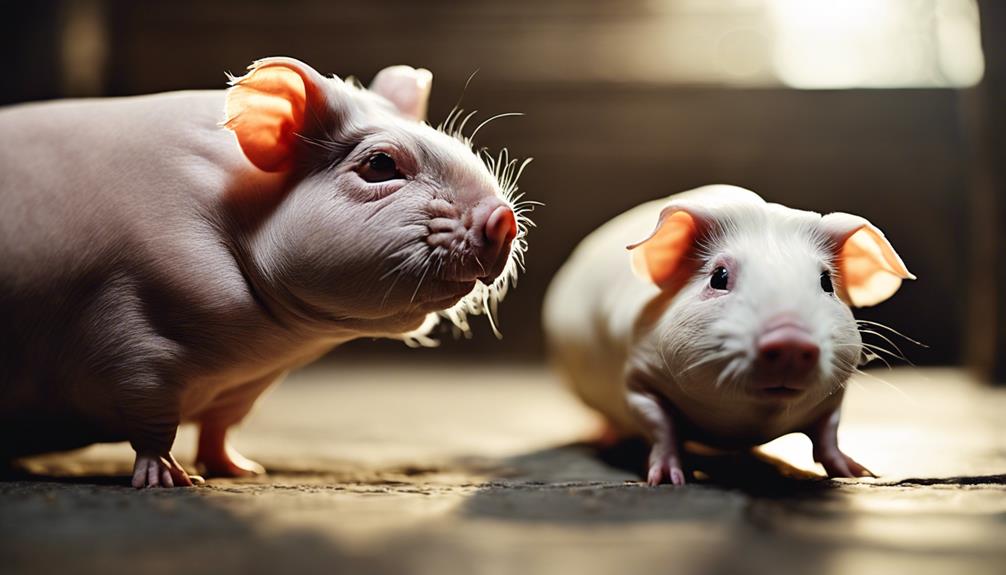
Skinny Pigs and Baldwins are both hairless guinea pig breeds.
The main difference between them lies in their origin.
Skinny Pigs come from South America, while Baldwins were first bred in the United States.
Origins of Skinny Pig and Baldwin
The origins of the Skinny Pig and Baldwin breeds differ in how their genetic mutations manifest regarding hair coverage. Skinny pigs stem from a genetic mutation that results in them being completely hairless from birth, originating from a lab setting at Montreal's Armand Frappier Institute.
In contrast, Baldwins are born with a full coat of hair, but due to a genetic mutation, they gradually lose their hair over time, eventually becoming entirely hairless as they mature. The breeding of skinny pigs outside the lab commenced in the 1990s, while Baldwins have been around for a longer period.
Both skinny pigs and Baldwins are a product of specific genetic mutations, but the key distinction lies in the fact that skinny pigs are born without hair, whereas Baldwins start their lives fully covered in fur before transitioning to a hairless state as they age.
Physical Characteristics of Skinny Pig
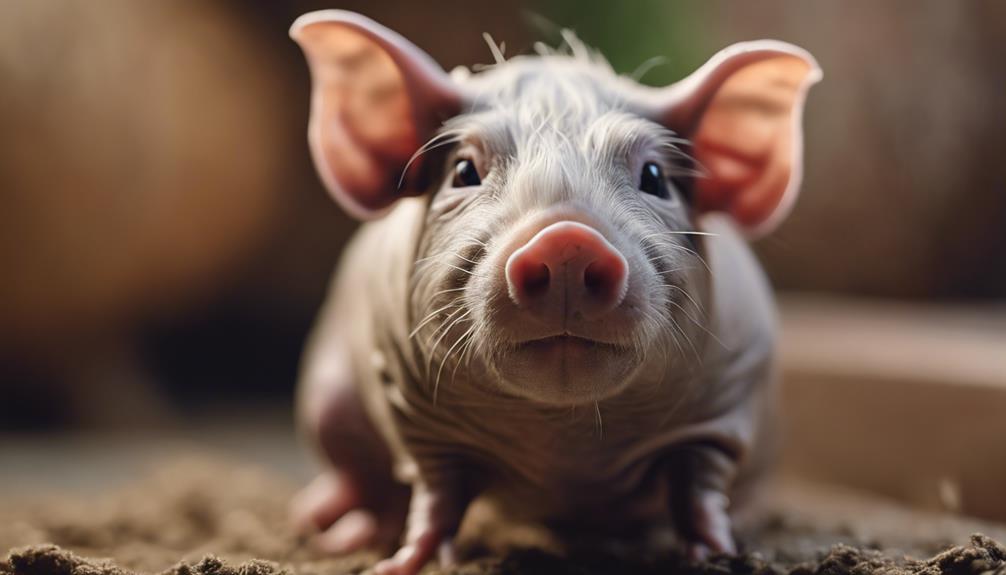
Originating from a genetic mutation that renders them hairless from birth, Skinny pigs exhibit distinct physical characteristics setting them apart from other guinea pig breeds. These unique guinea pigs are typically born without hair, although some varieties may have patches on their bodies, like on their muzzles, legs, or feet.
Notably, Skinny pigs can also have hair on their shoulders and backs, with some showcasing variations such as werewolf Skinny pigs. Their petal-shaped ears appear larger in comparison to their hairless bodies, adding to their unique appearance. Despite their lack of fur, Skinny pigs still require vitamin C in their diet, similar to their furry counterparts.
These physical traits make Skinny pigs stand out among guinea pig breeds, highlighting their special and distinctive characteristics when compared to Baldwin guinea pigs.
Physical Characteristics of Baldwin

Baldwin guinea pigs exhibit unique physical characteristics, notably characterized by their rubbery skin that's prone to dead skin cell buildup, ringworm, and bacterial infections. Their skin is thin, resembling that of an elderly person, making it easy to bleed.
As Baldwins mature, they may develop small pimples and produce more eye-cleaning substance. One distinctive feature of Baldwins is their larger and droopier ears compared to Skinny pigs.
Due to their skin's special needs, regular visits to an animal dermatologist are recommended for Baldwin owners to ensure their pets' health and well-being. Owners of Baldwins should be attentive to the unique skin conditions their pets may encounter, such as dead skin cell buildup and infections, and provide appropriate care to maintain their Baldwin's skin health.
Understanding these physical characteristics can help Baldwin owners provide the necessary care and attention to ensure their pets lead a healthy and happy life.
Temperament and Behavior Differences
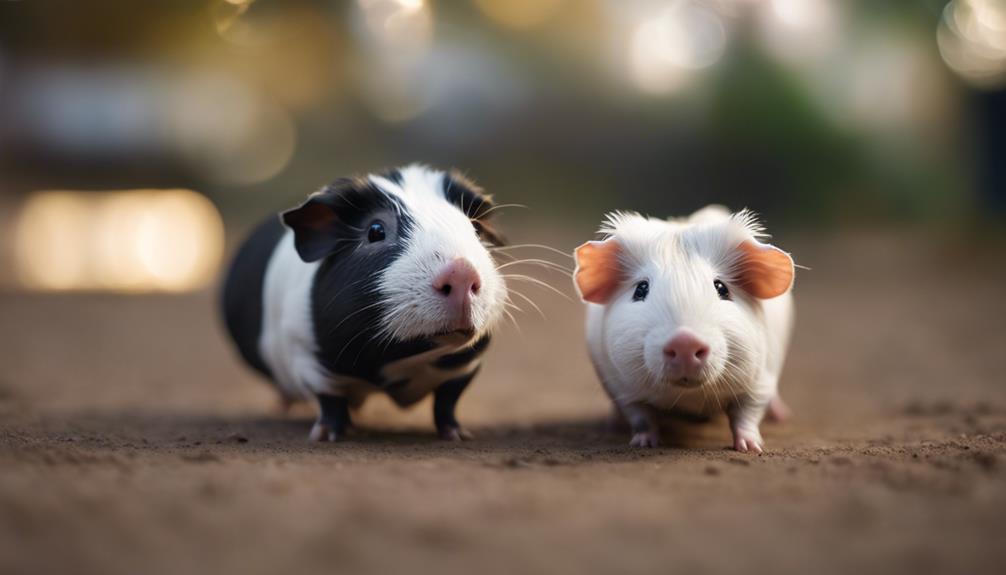
Skinny pigs are generally considered to be more lively and interactive in their behavior compared to Baldwin guinea pigs. They exhibit higher energy levels, curiosity, and a need for mental stimulation. On the other hand, Baldwins are known for their docile and calm temperament, enjoying cuddling and lap time with their owners. The table below summarizes the key temperament and behavior differences between skinny pigs and Baldwins:
| Aspect | Skinny Pigs | Baldwins |
|---|---|---|
| Activity Level | More active and playful | Docile and calm |
| Interaction | Curious, enjoy toys and interactive activities | Affectionate, form strong bonds with owners |
| Exploration | Display exploratory behavior | Enjoy cuddling and lap time |
| Need for Stimulation | Require mental stimulation | Prefer gentle interaction |
Health Considerations for Skinny Pigs
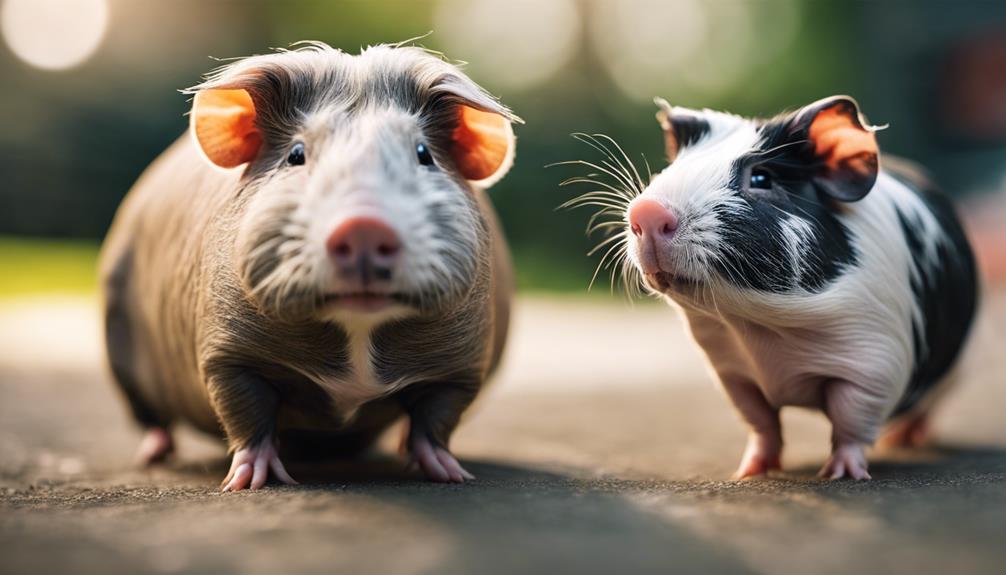
When caring for a Skinny Pig, it's essential to be mindful of specific health considerations unique to this hairless breed. Skinny pigs have certain vulnerabilities that require special attention:
- Skinny pigs require more food for energy due to their lack of insulation from hair.
- They're prone to overheating and heat stroke as they lack sweat glands.
- Proper temperature regulation is essential, and they should be kept indoors away from extreme temperatures.
To ensure the well-being of skinny pigs, regular veterinary check-ups are crucial. These check-ups help in early detection of any health issues and allow for timely interventions. By being proactive in monitoring their temperature, protecting them from the sun, and providing adequate nutrition, owners can help skinny pigs lead healthy and happy lives.
Health Considerations for Baldwins
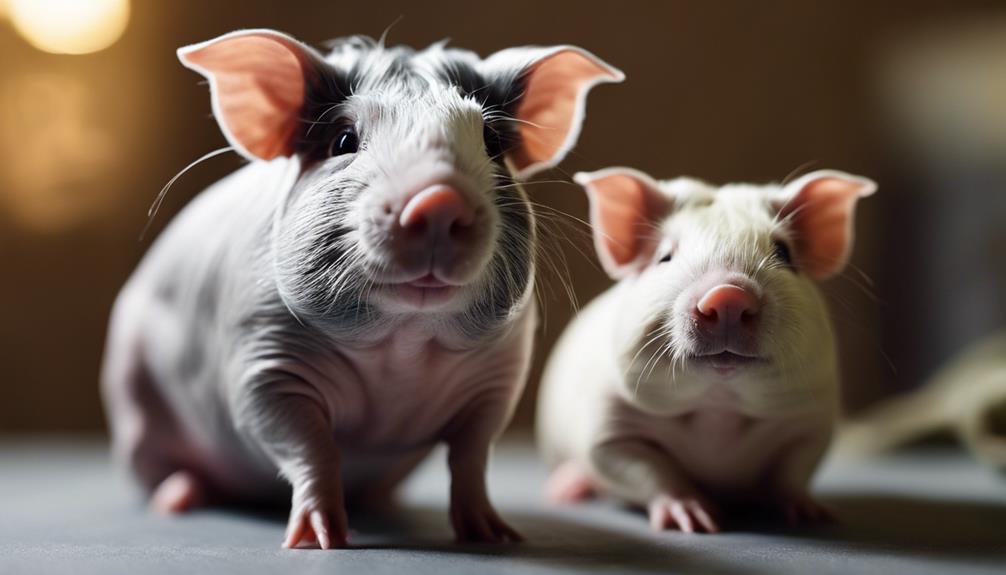
Considering the distinctive skin characteristics of Baldwins, their health requires specialized attention to prevent skin issues and maintain overall well-being. Due to their rubbery skin prone to dead skin cell buildup, ringworm, and bacterial infections, Baldwins need specific skin care routines to keep their skin healthy. Regular veterinary check-ups are essential for monitoring their skin health, as Baldwins are vulnerable to various dermatological problems. Maintaining an optimal body weight is challenging for Baldwins, necessitating a balanced diet and regular weight monitoring to prevent obesity or malnourishment.
Providing external heat sources is recommended for sick Baldwins to aid in their recovery and overall well-being. Additionally, ambient temperature plays a significant role in the health and comfort of Baldwins. Careful temperature regulation is crucial to prevent them from getting too cold or too hot, as extreme temperatures can adversely affect their well-being. By paying close attention to these health considerations, Baldwin owners can help ensure the overall health and happiness of their unique pets.
Care Requirements and Grooming Differences
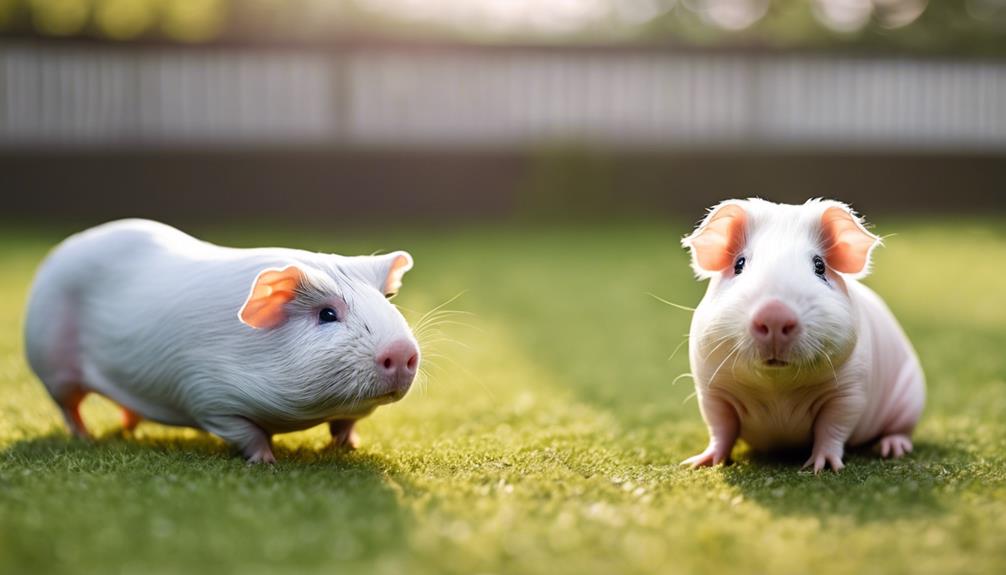
Care requirements and grooming differences between Skinny pigs and Baldwins vary significantly due to their distinct skin characteristics and hair coverage. When it comes to caring for these unique pets, there are some key differences to consider:
- Grooming Needs: Skinny pigs require less frequent grooming due to their minimal hair coverage, whereas Baldwins need regular bathing and skin care routines to prevent issues like dead skin cell buildup and infections.
- Skin Care: Skin care products for Baldwins should be gentle and tailored to their sensitive, hairless skin to avoid irritation and maintain skin health.
- Body Temperature Regulation: Baldwins may need more assistance in regulating their body temperature through external heat sources and warm bedding since they lack the insulation provided by fur.
Proper grooming practices are essential for both Skinny pigs and Baldwins to ensure their skin health and overall well-being. Owners should be attentive to these specific care requirements to keep their pets happy and healthy.
Frequently Asked Questions
How Big Do Baldwin Guinea Pigs Get?
Baldwin guinea pigs can reach an average weight of 2-3 pounds and grow to be 8-12 inches long. They have a stockier build compared to skinny pigs. Their larger, droopier ears and unique rubbery skin texture distinguish them.
What Two Animals Make a Skinny Pig?
Skinny pigs result from breeding a hairless guinea pig with a coated one. They inherit the hairless trait from one parent and some hair from the other. This genetic mix allows for various fur patterns and colors.
What Is the Difference Between a Skinny Pig and a Guinea Pig?
When comparing a skinny pig to a guinea pig, the key differences lie in their care needs, temperament, grooming requirements, health considerations, and dietary variations. Understanding these distinctions helps pet owners provide tailored care for these unique animals.
What Colors Are Baldwin Guinea Pigs?
Baldwin guinea pigs showcase a diverse array of colors like white, black, gray, and cream. Their breeding patterns and genetic mutations result in unique coat variations, such as brindle, Dalmatian, Dutch, Himalayan, and tortoiseshell, making them visually appealing pets.











